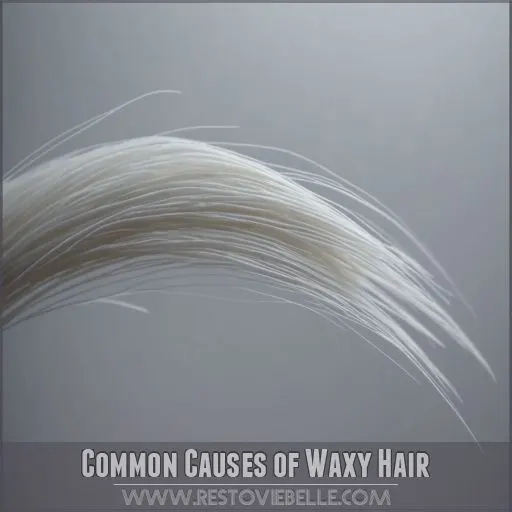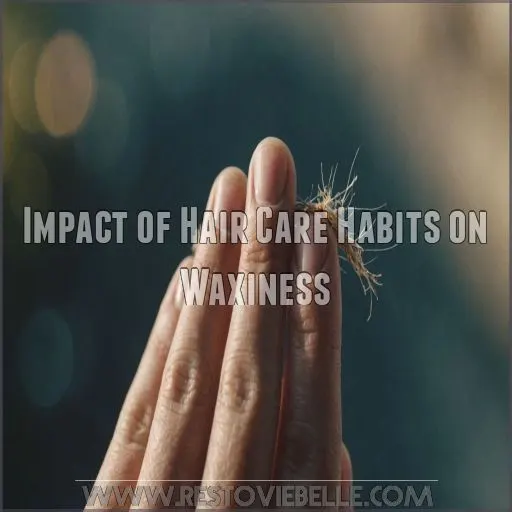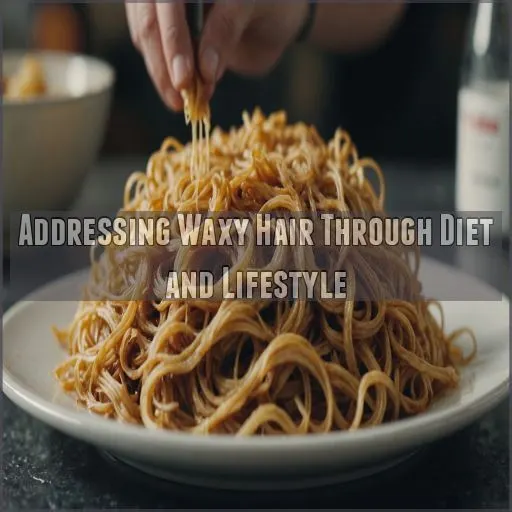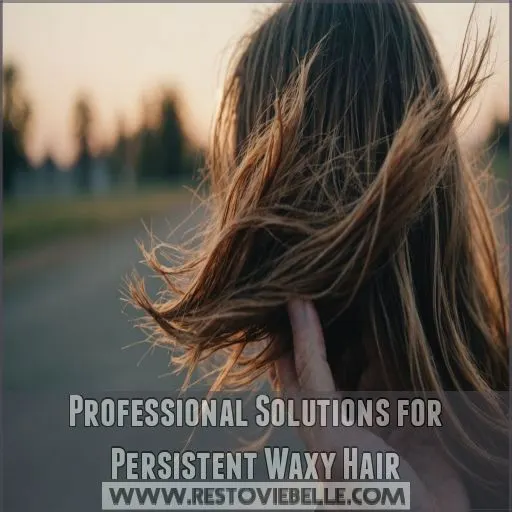This site is supported by our readers. We may earn a commission, at no cost to you, if you purchase through links.
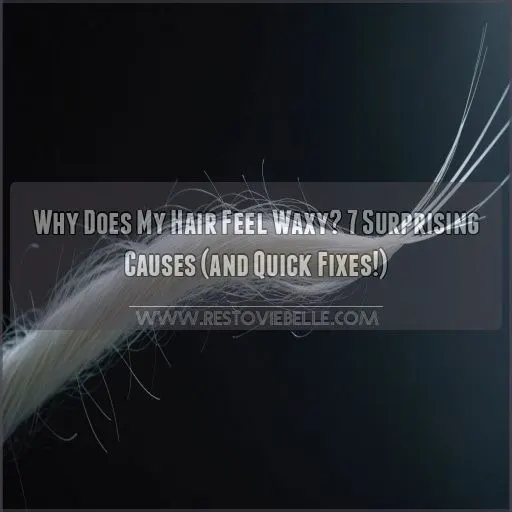 Ever wondered "why does my hair feel waxy" after washing? You’re not alone! This greasy, heavy sensation can be frustrating, but don’t worry—it’s often easily fixable.
Ever wondered "why does my hair feel waxy" after washing? You’re not alone! This greasy, heavy sensation can be frustrating, but don’t worry—it’s often easily fixable.
Common culprits include product buildup, excess sebum production, or hard water mineral deposits.
Your hair care routine might be the sneaky saboteur: using too much conditioner, not rinsing thoroughly, or washing too frequently can all lead to that waxy feeling.
Environmental factors and even your diet can play a role too.
The good news? With a few tweaks to your hair care habits, you can say goodbye to that waxy residue and hello to silky-smooth locks.
Curious about the surprising ways your lifestyle might be affecting your hair?
Table Of Contents
- Key Takeaways
- Common Causes of Waxy Hair
- How Product Buildup Creates a Waxy Feel
- Impact of Hair Care Habits on Waxiness
- Environmental Factors Contributing to Waxy Hair
- Addressing Waxy Hair Through Diet and Lifestyle
- Professional Solutions for Persistent Waxy Hair
- Frequently Asked Questions (FAQs)
- How do I get the waxy feeling out of my hair?
- Why does my hair feel sticky and waxy?
- Can hard water cause waxy hair?
- Why doesn’t my hair feel clean after washing?
- Can certain medications cause waxy hair?
- Does hair texture affect susceptibility to waxiness?
- Can scalp conditions like psoriasis cause waxy hair?
- How does humidity impact hair waxiness?
- Can using natural oils lead to waxy hair?
- Conclusion
Key Takeaways
- You’re not alone in this sticky situation – waxy hair is often caused by product buildup, excess sebum production, or hard water deposits. It’s like your locks are wearing an invisible, greasy hat!
- Your hair care routine might be the sneaky saboteur. Using too much conditioner, not rinsing thoroughly, or washing too frequently can all lead to that waxy feeling. Remember, finding your hair’s Goldilocks zone takes some trial and error!
- Environmental factors and lifestyle choices play a bigger role than you might think. From air pollution to your diet, these sneaky culprits can leave your tresses feeling less than fresh. Time to give your hair an environmental defense shield!
- Don’t throw in the towel just yet – with a few tweaks to your hair care habits, you can say goodbye to that waxy residue. From clarifying treatments to adjusting your washing frequency, you’ve got plenty of weapons in your arsenal to combat the grease monster.
Common Causes of Waxy Hair
Ever wondered why your hair feels like it’s coated in candle wax?
You’re not alone—waxy hair is a common frustration,
but understanding its causes is the first step to reclaiming your silky-smooth locks.
Excessive Sebum Production
Ever feel like your hair’s thrown in the towel and decided to be a greaseball? Excessive sebum production might be the culprit behind your waxy woes. Your sebaceous glands are working overtime, cranking out more oil than your hair can handle.
Hormonal changes, stress, and even your diet can send these tiny oil factories into overdrive.
Don’t worry, though – we’ve got some slick tricks up our sleeve to help you tame that shine!
Hard Water Mineral Buildup
You’ve tackled excess oil, but your hair still feels waxy? The culprit might be lurking in your pipes! Hard water‘s a sneaky saboteur, leaving mineral deposits that cling to your strands.
It’s like your hair’s wearing an invisible coat of armor – not the good kind. These stubborn minerals can make your locks feel heavy and look dull.
But don’t worry, we’ve got some tricks up our sleeve to combat this watery woe.
Incorrect Shampoo and Conditioner Usage
Hard water’s not the only culprit behind waxy hair, but mineral buildup from hard water can definitely contribute. Your shampoo and conditioner routine might be the sneaky saboteur! Using the wrong products or applying them incorrectly can leave your locks feeling like a candle. Here’s what might be going wrong:
- Overloading your roots with heavy conditioners
- Skipping clarifying treatments and letting build-up party on
- Mismatching products to your hair type (like using ultra-moisturizing formulas on fine hair)
Remember, finding your hair’s Goldilocks zone takes some trial and error!
Incomplete Rinsing After Washing
Think you’ve rinsed all that shampoo and conditioner out? Think again! Incomplete rinsing is like leaving soap on your dishes – it’s a recipe for disaster.
Your hair can end up feeling waxy and looking dull.
The culprit? Conditioner residue clinging to your strands, especially if you’ve got thick or curly locks.
Don’t worry, though – we’ve got some nifty rinsing techniques up our sleeve to save your hair’s texture!
Seborrheic Dermatitis and Scalp Conditions
Itchy, flaky scalp got you scratching your head? Seborrheic dermatitis might be the culprit behind your waxy hair woes. This pesky condition can wreak havoc on your scalp, leaving you with:
- Excessive oil production
- Stubborn dandruff flakes
- Redness and irritation
- Waxy buildup on hair strands
Don’t let seborrheic dermatitis dampen your style! With the right treatment and a little TLC, you can restore your scalp’s health and say goodbye to that greasy, waxy feeling.
How Product Buildup Creates a Waxy Feel
Ever wondered why your hair feels like it’s coated in wax, even after washing?
Product buildup is a sneaky culprit that can leave your locks feeling heavy and greasy,
thanks to ingredients that cling to your strands long after you’ve rinsed them out.
Silicone-Based Ingredients
Peering into your bathroom cabinet, you might be surprised to find silicone-based ingredients lurking in your hair products.
These sneaky additives can create a waxy buildup on your strands, leaving you wondering why your hair feels so heavy.
While they promise shine and smoothness, silicones can accumulate over time, trapping natural oils and altering your hair’s texture.
Don’t fret! Switching to silicone-free alternatives can help restore your hair’s natural balance and bounce.
Leave-in Treatments and Their Effects
While silicones can weigh down your locks, leave-in treatments might be the hidden culprit behind your waxy woes.
These products, designed to nourish and protect, can sometimes overstay their welcome.
From leave-in conditioners to hair oils, they can accumulate on your strands, creating a sticky film.
The result? Hair that feels waxy, looks greasy, and loses its bounce.
Let’s unravel this hairy situation!
Dry Shampoo Residue Accumulation
Though dry shampoo can be a lifesaver, overusing it can leave your hair feeling waxy. This powder-based product absorbs excess oil, but it doesn’t actually clean your hair. Instead, it builds up on your scalp, creating a gritty, waxy feel.
To avoid this, try:
- Limiting dry shampoo use to 2-3 times a week
- Applying it sparingly, focusing on the roots
- Using a clarifying shampoo regularly to remove residue like product buildup can help revive colored hair
Remember, your scalp needs some natural oils to stay healthy!
Hairspray and Gel Overuse
Ever feel like your hair’s throwing a sticky rebellion?
Excessive use of hairspray and gel can leave you with a waxy mess.
These styling products often contain ingredients that cling to your strands, creating a stubborn buildup.
As layers accumulate, your once-bouncy locks might start feeling more like a candle than hair!
Don’t worry, though—we’ll get you back to hair heaven in no time.
Natural Oil Trapping by Product Residue
Despite your best efforts, your hair care routine might be working against you. Product residue can act like a magnet for your scalp’s natural oils, trapping them and creating that frustrating waxy feel. It’s like your hair’s wearing an invisible, greasy hat! This buildup affects your hair’s texture but can also throw off your scalp’s delicate oil balance.
Don’t worry, though—we’ve got solutions up our sleeve!
Impact of Hair Care Habits on Waxiness
Your daily hair care routine might be the sneaky culprit behind that waxy feeling you’re battling.
From how often you shampoo to the water temperature in your shower, seemingly innocent habits can throw your scalp’s oil production into chaos and leave your locks feeling less than fresh.
Frequency of Hair Washing
You might think washing your hair daily keeps it clean, but it could be the culprit behind that waxy feel.
Frequent washing can strip your scalp of natural oils, prompting it to overproduce sebum as a defense mechanism.
This excess oil can leave your locks feeling greasy and waxy.
Finding the right balance for your hair type is key to maintaining scalp health and avoiding product build-up.
Water Temperature During Washing
While washing frequency matters, water temperature plays a big role too.
Hot showers might feel great, but they’re not doing your hair any favors.
Scalding water strips away natural oils, leaving your locks feeling waxy and dry.
On the flip side, icy rinses can shock your scalp, causing it to overproduce sebum.
The sweet spot? Lukewarm water that’ll keep your mane happy and healthy.
Overwashing and Scalp Oil Imbalance
Going for squeaky-clean hair might actually backfire, leaving you with a waxy mess. Overwashing strips your scalp of natural oils, triggering overproduction of sebum to compensate. This oil imbalance can leave your locks feeling greasy and waxy, even right after washing.
Overwashing can lead to your scalp going into oil-production overdrive.
- Yikes! Your hair’s sending an SOS signal!
- Ugh, it’s like your scalp’s gone into oil-production overdrive.
- Whoops, you’ve accidentally triggered the grease monster.
- Eek! Your hair’s throwing a sebum party you didn’t RSVP to.
- Oh no, you’ve stumbled into a slippery slope of waxiness.
Lack of Clarifying Treatments
Many hair enthusiasts overlook the power of regular clarifying treatments.
These deep-cleansing champions can be your secret weapon against waxy buildup.
Think of them as a reset button for your locks, whisking away stubborn residues that your everyday shampoo might miss.
From apple cider vinegar rinses to specialized clarifying shampoos, incorporating these treatments into your routine can keep your tresses feeling fresh and light.
Incorrect Brushing and Combing Techniques
Did you know your brushing habits could be turning your locks into a waxy mess?
Your trusty hairbrush might be your hair’s worst enemy if you’re not careful.
Brushing too often or with the wrong tools can distribute oils unevenly, leading to that greasy feel.
Plus, aggressive combing can damage your scalp, triggering excess oil production.
Let’s untangle these bad habits and get your hair back to its silky-smooth self!
Environmental Factors Contributing to Waxy Hair
You might be surprised to learn that your environment plays a big role in making your hair feel waxy.
From air pollution to chlorine in pools, everyday factors can leave your locks feeling less than fresh – but don’t worry, we’ve got some quick fixes up our sleeve!
Air Pollution and Particulate Matter
Living in the concrete jungle? Your hair might be catching more than just compliments. Urban air pollution bombards your locks with particulate matter, creating a sticky film that can leave your tresses feeling waxy. These microscopic pollutants cling to your hair, trapping oils and dirt.
To combat this, try using an air purifier at home and consider wearing a stylish hat or scarf when you’re out and about. Your hair will thank you!
Humidity and Its Effects on Hair
You’ve tackled air pollution, but humidity’s another hair-raising challenge! This invisible moisture menace can leave your locks feeling waxy and unmanageable. Here’s how humidity affects your hair:
- Frizz frenzy: Moisture seeps into hair shafts, causing swelling
- Styling struggles: Products lose effectiveness in high humidity
- Texture troubles: Straight hair goes limp, curly hair poofs up
- Grease overload: Humidity traps oils, making hair feel waxy
Don’t let the weather dampen your style! We’ll explore humidity-fighting tricks to keep your tresses looking terrific.
Chlorine and Salt Water Exposure
While humidity can make your hair frizzy, chlorine and salt water are sneaky culprits behind that waxy feel.
These aquatic villains strip your hair’s natural oils, leaving it parched and prone to product buildup.
Ever noticed your locks feeling like straw after a dip? That’s chlorine damage in action.
Salt water’s no angel either – it can leave a crusty residue that traps other substances, creating a waxy nightmare.
Seasonal Changes and Hair Texture
Just as you might switch up your wardrobe, your hair needs seasonal care too.
Winter’s cold can leave your locks parched and prone to waxiness, while summer’s humidity might make them frizzy and sticky.
Spring’s pollen can cling to your strands, and fall’s dryness might increase static.
Don’t fret! Adjusting your hair care routine with the seasons can help you maintain that perfect, non-waxy texture year-round.
Occupational Hazards and Hair Health
Your job can affect your hair more than you might think! Certain professions expose your locks to unique challenges. Here are some occupational hazards that could leave your hair feeling waxy:
- Salon workers: constant chemical exposure
- Construction workers: dust and grime buildup
- Chefs: grease and food particles
- Office workers: excessive product use for "polished" look
- Swimmers: chlorine residue
Don’t worry, though! We’ll explore solutions to keep your tresses healthy, no matter your career path.
Climate-Specific Hair Care Challenges
In the face of climate challenges, your hair might feel like it’s staging a rebellion! Humidity can turn your locks into a frizzy mess, while sun exposure dries them out faster than you can say "beach day."
Cold weather saps moisture, leaving your tresses feeling brittle and waxy. Wind whips up tangles, and pollution clings to strands like unwanted guests. It’s a hair-raising battle against the elements!
Addressing Waxy Hair Through Diet and Lifestyle
You might be surprised to learn that your diet and lifestyle choices can really impact your hair’s texture, including that pesky waxy feeling.
From nutritional deficiencies to stress levels, we’ll explore how everyday habits could be contributing to your hair woes and offer some quick fixes to help you achieve the silky-smooth locks you’re after.
Nutritional Deficiencies and Hair Health
From the inside out, your hair’s health reflects your diet.
Lacking essential nutrients can lead to waxy, lifeless locks.
Ever wonder why your mane feels like a candle?
It might be crying out for some TLC from your plate.
Biotin, vitamin D, iron, and protein are your hair’s best friends.
Boost these in your diet, and you’ll be on your way to silky, smooth tresses in no time!
Hormonal Imbalances and Sebum Production
Moving beyond nutrition, let’s talk about how your hormones might be turning your luscious locks into a waxy mess. Hormonal imbalances can throw your sebum production into overdrive, leaving you with greasy roots faster than you can say "bad hair day." Here’s the lowdown on how hormones affect your hair:
- Testosterone surge = oilier scalp
- Estrogen dip = drier hair (hello, menopause!)
- Thyroid troubles = changes in hair texture
- Cortisol spikes = more sebum production
- Insulin resistance = potential hair thinning
Stress Management for Scalp Health
Believe it or not, your stress levels could be turning your locks into a waxy mess.
When you’re frazzled, your body kicks sebum production into overdrive, leaving your hair feeling greasy.
Take a deep breath and try some stress-busting techniques like scalp massage, mindfulness, or yoga.
These will help you unwind, and they’ll also promote better circulation to your scalp, potentially reducing that pesky waxy feeling.
Hydration and Its Impact on Hair
If you’re thinking about hydration, your hair’s thirst is real! Drinking enough water isn’t just good for your body; it’s a game-changer for your locks.
Proper hydration can help:
- Wash away that waxy feeling, leaving your hair silky smooth
- Boost hair growth, giving you luscious, Rapunzel-worthy tresses
- Combat dryness and frizz, taming your mane into submission
So, next time you’re feeling parched, remember: your hair’s begging for a sip too!
Exercise and Scalp Circulation
You might not realize it, but exercise is your hair’s secret weapon against waxiness.
By getting your heart pumping, you’re boosting blood flow to your scalp, which can work wonders for hair health.
This increased circulation delivers key nutrients to your follicles, but it also helps regulate sebum production.
Plus, breaking a sweat can be a great stress-buster, indirectly benefiting your luscious locks.
Sleep Quality and Hair Care
During your beauty sleep, your hair’s getting a makeover too! Poor sleep can spike stress hormones, leading to oily roots and that pesky waxy feel. It’s not just about catching Z’s; quality shut-eye is important for healthy hair growth cycles.
Tossing and turning? You might be rubbing your locks against rough pillowcases, causing friction and buildup. So, hit the hay early and wake up to silkier strands!
Professional Solutions for Persistent Waxy Hair
If your hair still feels waxy despite your best efforts, it might be time to call in the professionals.
From trichologist consultations to advanced scalp treatments, expert solutions can tackle even the most stubborn cases of waxy hair and get your locks feeling fresh again.
Trichologist Consultations and Diagnoses
If your hair’s still feeling waxy after trying home remedies, it’s time to call in the big guns: a trichologist.
These hair and scalp experts can pinpoint what’s making your locks feel like a candle.
- In-depth scalp analysis
- Hair fiber examination
- Personalized treatment plan
Think of a trichologist as a hair detective, solving the mystery of your waxy mane. They’ll uncover the root cause and help you say goodbye to that greasy feeling for good.
Scalp Treatments and Therapies
Ready to pamper your scalp? Professional treatments can work wonders on persistent waxiness. Imagine a soothing scalp massage melting away product buildup, or micro-needling stimulating those sleepy follicles.
Scalp scrubs might be your new best friend for a deep cleanse.
For high-tech solutions, laser therapy can kickstart circulation. Don’t forget the power of luxurious oil treatments – they’re like a spa day for your scalp!
Custom Hair Care Regimens
When scalp treatments don’t cut it, a custom hair care regimen might be your golden ticket.
Your stylist can craft a personalized plan suited to your hair type and regimen goals.
They’ll recommend the perfect product selection and routine frequency to banish that waxy feel.
Remember, one size doesn’t fit all – what works for your bestie might turn your locks into a grease fest.
Professional advice is key to cracking the code on your unique hair puzzle.
Medical Interventions for Underlying Conditions
Persistent waxy hair can be a real head-scratcher, but don’t throw in the towel just yet! Sometimes, the root cause goes deeper than your usual hair care routine.
Your doctor might recommend blood tests to check for hormonal imbalances or nutrient deficiencies.
For stubborn scalp infections or dermatitis, prescription shampoos can work wonders.
Remember, tackling underlying conditions is key to getting your locks back to their silky-smooth glory.
Advanced Hair Detox Procedures
For those stubborn cases of waxy hair, advanced hair detox procedures can be your secret weapon.
These professional treatments go beyond your typical wash-and-rinse routine.
Imagine giving your scalp a spa day with deep cleansing charcoal masks and invigorating clay treatments.
Detoxifying shampoos and scalp exfoliation techniques work wonders to remove buildup, especially when dealing with waxy residue.
It’s like hitting the reset button on your hair, leaving you with a fresh, clean slate.
Prescription Treatments for Scalp Issues
Have you exhausted all over-the-counter options for your waxy hair? It might be time to consult a dermatologist.
They can prescribe treatments made just for your specific scalp issues, like medicated shampoos or oral medications.
These powerful solutions can tackle stubborn problems like seborrheic dermatitis or psoriasis.
Just remember, prescription treatments often pack a punch, so discuss potential side effects with your doc before diving in.
Your journey to silky-smooth locks might be just a prescription away!
Frequently Asked Questions (FAQs)
How do I get the waxy feeling out of my hair?
You’ll want to telegraph your hair’s SOS.
Use a clarifying shampoo weekly, rinse thoroughly, and try an apple cider vinegar rinse.
Double-cleanse if needed, and consider a shower filter for hard water.
Why does my hair feel sticky and waxy?
Your hair’s sticky, waxy feel could be due to product buildup, over-washing, or hard water.
It’s like your locks are wearing a tiny sweater they can’t take off!
Clarifying shampoos and proper rinsing can help strip away the gunk.
Can hard water cause waxy hair?
Imagine your hair turning into a wax sculpture!
Yes, hard water can cause waxy hair.
It’s loaded with minerals that build up on your locks, leaving them feeling coated.
You’re not imagining things—it’s a real problem!
Why doesn’t my hair feel clean after washing?
Insufficient rinsing, product buildup, or hard water might be the culprits.
You’re not alone in this slippery situation!
Try double-cleansing, using a clarifying shampoo weekly, or installing a shower filter to combat these pesky problems.
Can certain medications cause waxy hair?
Yes, certain medications can lead to waxy hair.
Some drugs affect sebum production or alter hair texture.
If you’ve noticed changes after starting a new medication, consult your doctor.
They’ll help identify if it’s the culprit.
Does hair texture affect susceptibility to waxiness?
Your hair texture does influence how prone it’s to waxiness.
Fine hair can get greasy faster, while coarse hair might trap more product.
Curly hair’s natural oils don’t travel as easily, potentially leading to buildup.
Can scalp conditions like psoriasis cause waxy hair?
Scalp conditions like psoriasis can indeed contribute to waxy hair.
They often cause flaking and excess oil production, which can build up on your strands.
It’s like having a tiny snowstorm on your head!
Consult a dermatologist for treatment options.
How does humidity impact hair waxiness?
While humidity can make hair frizzy, it’s not typically linked to waxiness.
High moisture levels might exacerbate product buildup, though.
You’ll want to adjust your hair care routine during humid weather, focusing on lightweight, non-greasy products to maintain balance.
Can using natural oils lead to waxy hair?
Natural oils can indeed lead to waxy hair if you’re heavy-handed.
They’re a double-edged sword – nourishing in small amounts but potentially greasy if overused.
It’s all about finding that sweet spot for your unique hair type.
Conclusion
Did you know that 75% of people experience waxy hair at some point? Now you understand why your hair feels waxy and how to fix it.
From product buildup to hard water, various factors can contribute to this pesky problem.
By adjusting your hair care routine, considering environmental impacts, and making lifestyle tweaks, you can say goodbye to that greasy feeling.
Remember, healthy hair starts with a healthy scalp. If waxy hair persists, don’t hesitate to consult a professional for personalized solutions. Your journey to silky-smooth locks starts now!

